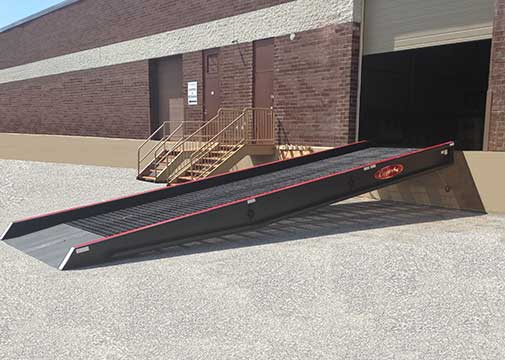Working With 5000 lb Loading Ramps
As a business owner, you’re always looking to streamline your operations and improve efficiency. One area that many commercial enterprises overlook is the loading and unloading of heavy equipment and machinery. The process can be time-consuming, difficult, and even dangerous without the right equipment. That’s why it’s crucial to have the proper loading ramp for your needs. In this blog post, we’ll discuss the importance of 5000 lb loading ramps for commercial use and how they can make a significant impact on your business’s productivity and safety.
The Benefits of Using 5000 lb Loading Ramps for Commercial Purposes
The benefits of utilizing 5,000 lb. loading ramps for commercial purposes are manifold. Specifically designed to facilitate the transportation of heavy equipment and machinery, these ramps contribute to increased efficiency, safety, and convenience. With an impressive weight capacity of 5,000 lbs., these ramps effortlessly handle even the heaviest loads, ensuring durability and longevity, thereby making them a cost-effective investment for businesses.
The use of commercial ramps significantly reduces the risk of workplace injuries by providing a secure and stable platform for loading and unloading heavy equipment. Moreover, the expedited loading and unloading times enhance productivity and minimize downtime. The mobility factor of these ramps, allowing easy transportation between locations, is especially advantageous for businesses requiring flexibility in their operations.

When considering a 5,000 lb. loading ramp for commercial use, it’s imperative to select the right type based on the specific needs of the business. Stationary ramps are suitable for businesses requiring a permanent loading solution, while portable ramps are ideal for those needing mobility. Material selection is another critical factor, with aluminum ramps being lightweight and durable, making them a popular choice, while steel ramps, though heavier, offer greater weight capacity and durability.
Additionally, the slope of the ramp must be taken into account during the selection process. A gradual slope is recommended to ensure ease of use and safety during the loading and unloading of equipment. By carefully considering these factors, businesses can make informed decisions, choosing the right type of 5,000 lb. loading ramp that aligns with their operational needs and guarantees efficient loading and unloading processes. Ultimately, the benefits derived from these ramps far exceed the initial investment, establishing them as a strategic and valuable asset for long-term business success.
How to Choose the Right Type of 5000 lb Loading Ramp for Your Business
When selecting a loading ramp for your commercial needs, it’s important to consider the type of equipment you’ll be using and the weight capacity required. The two main types of commercial ramps are stationary and portable. Stationary ramps are ideal for businesses that require a permanent loading solution, while portable ramps are perfect for businesses that need to move their ramp from one location to another.
Another important factor to consider is the material of the ramp. Aluminum ramps are lightweight and durable, making them a popular choice for many businesses. Steel ramps, on the other hand, are heavier but offer greater weight capacity and durability.

Lastly, consider the slope of the ramp. The steeper the slope, the more difficult it will be to load and unload equipment. It’s recommended to choose a ramp with a gradual slope to ensure safety and ease of use.
By taking these factors into consideration, you can choose the right type of 5000 lb loading ramp that meets your business needs and ensures efficient loading and unloading processes.
Tips and Best Practices When Using 5000 lb Loading Ramps in a Busy Workplace
5,000 lb. loading ramps are a great investment for any business, but they can be dangerous if not used properly. Here are some tips and best practices to keep in mind when using your ramp:
- Always make sure the ramp is secured properly before use.
- Inspect your ramp regularly for signs of wear or damage.
- Check the weight capacity of your ramp and never exceed it.
- Position the ramp on level ground and ensure it’s at the right height based on what you’re loading onto.
- Use proper lifting techniques when moving heavy objects up or down the ramp.
- Have clear communication with others involved in loading/unloading processes to avoid accidents.
Following these simple steps will help ensure that you get maximum use out of your 5000 lb loading ramp while staying safe at work.
Prioritizing Safety: Establishing Proper Usage and Handling Protocols for Your Commercial Ramp
Safety takes precedence, especially in bustling workplaces utilizing loading ramps with a capacity of 5000 lb. Implementing correct usage and handling procedures is paramount to prevent accidents and injuries. Always ensure the secure attachment of the ramp to the loading dock or truck bed before utilization. Confirm that the ramp’s weight capacity is not surpassed and that the load is evenly distributed. Exercise caution when maneuvering equipment or vehicles on and off the ramp, avoiding abrupt stops or turns. Conduct regular inspections for any signs of damage or wear, addressing issues promptly before resuming use. Lastly, furnish comprehensive training to all employees using the ramp, ensuring their understanding of safe and effective usage.
In summary, 5000 lb loading ramps are indispensable for businesses requiring the secure and efficient transportation of heavy equipment or goods. With advantages such as heightened productivity, decreased injury risk, and user-friendly features, commercial ramps have become a necessity across various industries. When selecting the appropriate ramp for your business, consider factors like weight capacity, material, and durability. Proper maintenance and timely repairs are crucial to ensure the ramp’s longevity and safety. By adhering to proper usage and handling protocols, you not only safeguard your employees and equipment but also optimize workplace productivity.
















